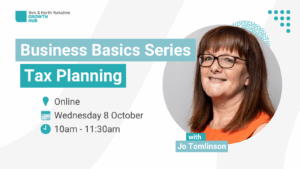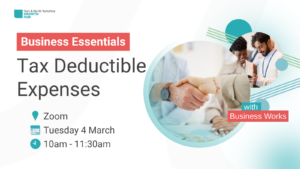Business Basics – Making Tax Digital
Making Tax Digital (MTD) for Income Tax and Rental Income is the biggest change to Self-Assessment since it was launched by HMRC over 30 years ago.
From April 2026, new rules will apply. Following MTD for VAT (introduced in 2019), sole traders and landlords with qualifying income must:
- Keep digital records
- Submit quarterly updates to HMRC
- Use compatible software to file their Self-Assessment return
The rollout will be phased:
- April 2026 – qualifying income over £50,000
- April 2027 – qualifying income over £30,000
- April 2028 – qualifying income over £20,000
Qualifying income (turnover test)
- Qualifying income means gross income from self-employment and property
- MTD does not include savings, dividends, or partnership income
- Trading allowance, property allowance and rent-a-room relief are not included
If your relevant period is less than 12 months, income must be adjusted on a just and reasonable basis (e.g. in your first year of trading).
If your income exceeds £50k in 2024/25, you must comply from April 2026, even if it later drops below the threshold.
If you’re new to Self-Assessment and cross the income threshold, you join MTD from 6 April after your first tax return is due.
You do not need to start using MTD until after you’ve submitted your first return, but you can choose to join early.
Why is HMRC doing this?
HMRC wants to modernise how small businesses handle tax and reduce errors. From the relevant date, you must:
- Keep records digitally
- provide digital quarterly updates
- be able to provide their Self-Assessment return information to HMRC through MTD compatible software
How MTD works in practice
1. Keep digital records
- You must record transactions digitally and store them in MTD-compatible software
- Manual calculations are no longer sufficient
- You can enter data manually or link your bank account/data capture tool to your software
- You may want to link other 3rd party software to your MTD software, avoiding double keying. Be sure to check the set up and mapping carefully if you do this
2. Submit via MTD-compatible software
Once you’re under MTD, you must make two types of submission:
Quarterly updates
- These are not tax returns
- They’re summaries based on your digital records
- You’ll see an estimated tax bill, but don’t need to pay quarterly
Self-Assessment return
- Still due by 31 January
- Filing process stays similar
- Payment deadlines also remain unchanged
- HMRC’s free online tool can no longer be used once you’re filing under MTD
You can:
- Use one piece of software that handles both quarterly updates and Self-Assessment tax returns
- Use two pieces of software that together meet all MTD requirements
If your accountant handles your Self-Assessment return, your software only needs to be able to submit quarterly updates.
Software must support all the income sources you need to report:
- Self-employment
- UK Property
- Foreign Property
- Savings
- Dividends
Still using spreadsheets?
- Bridging software will be needed to stay compliant
3. Quarterly update deadlines
Updates must be submitted by the 7th of the month after the quarter ends. You can choose to report using either historic reporting periods (aligned with tax year) or calendar quarters. Below is a comparison:
| Staying with historic reporting periods | Opting for calendar quarters | Filing deadline |
| Start: 6 Apr – End: 5 Jul | Start: 1 Apr – End: 30 Jun | 7 Aug |
| Start: 6 Jul – End: 5 Oct | Start: 1 Jul – End: 30 Sep | 7 Nov |
| Start: 6 Oct – End: 5 Jan | Start: 1 Oct – End: 31 Dec | 7 Feb |
| Start: 6 Jan – End: 5 Apr | Start: 1 Jan – End: 31 Mar | 7 May |
The Self-Assessment filing and payment deadline remains 31 January.
Quarterly filings: what to expect
You’ll need to submit 4 updates a year. If you’re logging records regularly, this should be straightforward.
- Most software allows one-click filing
- Weekly record-keeping helps avoid missing receipts
- Up-to-date data shows your position clearly – who owes you, who you owe, and estimated tax
Your quarterly updates must reflect your actual income and expenses. Inadequate records may result in penalties.
What to do now
- Check if and when you’ll be caught by MTD
- Sign up before the tax year you need to comply (based on your previous year’s return)
- HMRC will notify you when to sign up
Choose MTD-compatible software:
- You must file both quarterly updates and an end-of-year Self-Assessment Tax return
- If you have an Agent or accountant who submits your Self-Assessment Tax return already, your software only needs to do quarterly updates
- HMRC’s online tool cannot be used once you’re within MTD
Taxpayers caught by MTD must complete Self-Assessment returns using third-party software
Choose which accounting periods you want to report for your quarterly update:
- You can report the quarterly updates by tax year quarter ends (to 5 April) or by calendar quarters (to 31 March etc.)
- Some software only supports calendar periods – check before choosing
- You must decide and set your preference before your first submission
- This only relates to the Quarterly submissions. If you choose calendar quarters (in line with your VAT) you will need to add transactions from 1st to 5th April for your Self-Assessment tax return
Consider the benefits of MTD:
If you currently submit your own Self-Assessment tax return using HMRC’s software and don’t have software, this will all seem daunting, but this legislation will actually benefit business owners, as:
- Using software is:
- More efficient – linking your business bank account will save loads of keying and the artificial intelligence features built into the software save time too
- Will reduce errors
- Gives you access to reporting functionality (varies with different software), to help you run your business
- Updating your records more frequently will:
- Mean you lose less receipts
- Remember what transactions relate to more easily
- Mean you don’t have that stressful period where the whole year needs to be processed (it really is easier to manage in smaller chunks)
- Mean you can see who you owe and who owes you to improve cash flow visibility
- Be able to run reports and see how your business is performing throughout the year
- Have early visibility of your tax estimate
Note – We recommend updating your transactions and matching them to your bank entries on a weekly basis.
Explore the Business Basics Series: Webinar Recordings & Blogs
Business Basics – Making Tax Digital
Making Tax Digital (MTD) for Income Tax and Rental Income is the biggest change to Self-Assessment since it was launched by HMRC over 30 years ago.
Business Essentials: What is a Tax Deductible Expense?
As a business owner, it can be daunting when you are trying to work out what you can and can’t claim as tax deductible expense. Other business owners will give you their opinion but is that the right advice for you and your business? You can search online, but this can be confusing and often contradictory. So, what can you claim?
The legal requirements for starting a business
The legal requirements for starting a business can seem intimidating...
How digital tax will benefit your business
You will probably have heard about digital tax but what does it actually mean for you and how will it benefit your business?
Business advice from HMRC
HMRC are known for handling taxes, but it also has a lot of really business advice.
Research and development tax relief
If you are working on a project that is going to advance knowledge or capacity, you might qualify for tax relief.
What is PAYE (Pay As You Earn)?
Pay as you earn (PAYE) is the easiest way for you to pay Income Tax...







